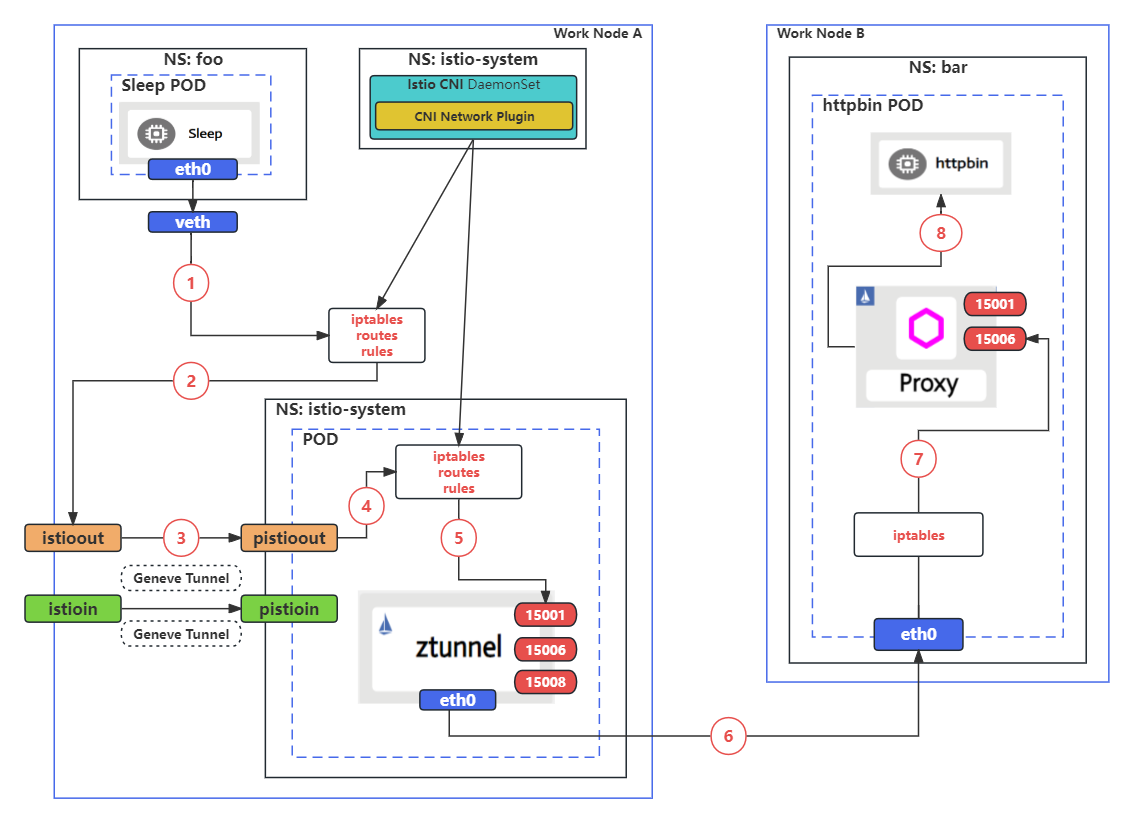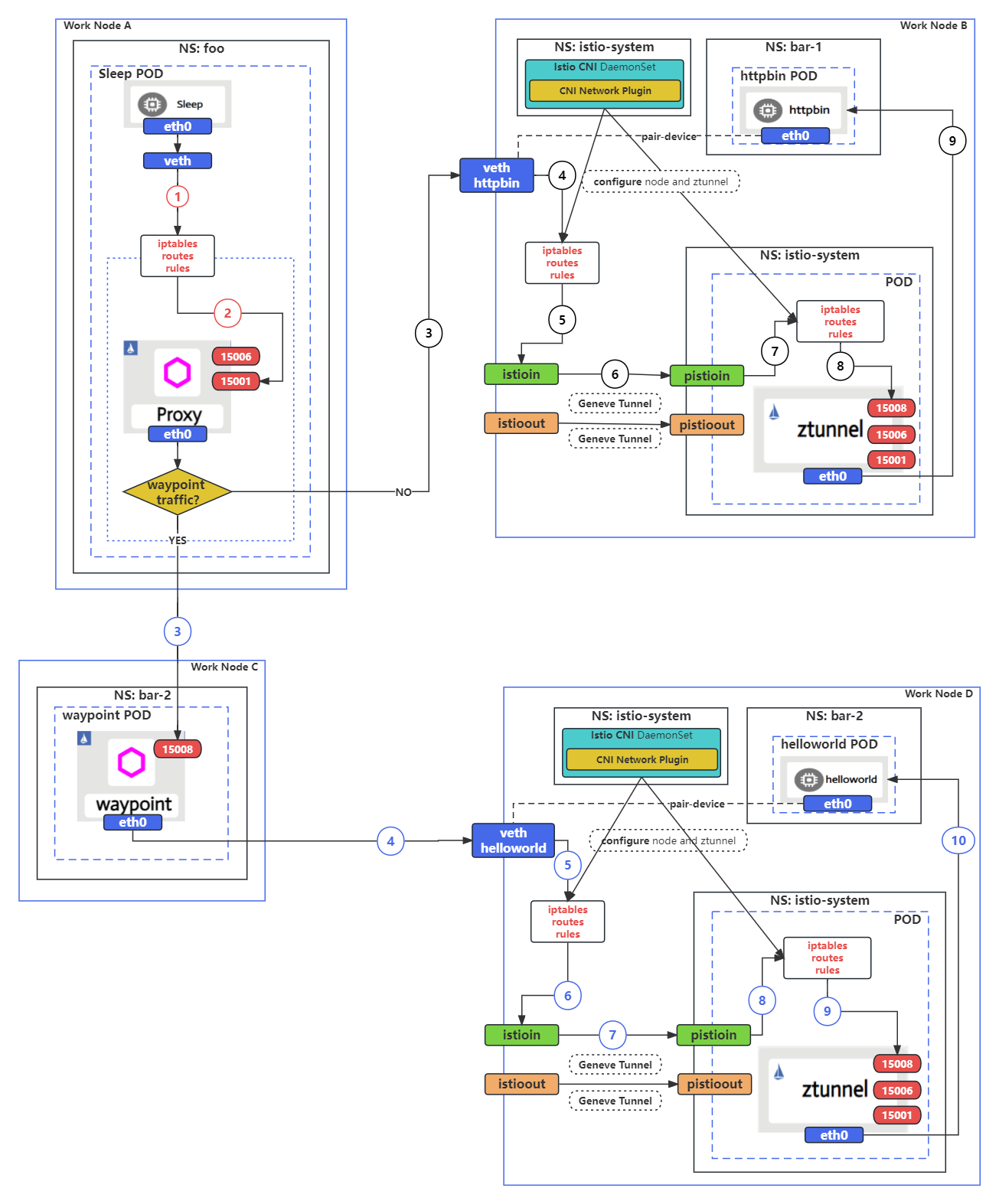Deep Dive into the Network Traffic Path of the Coexistence of Ambient and Sidecar
Deep Dive into the Traffic Path of the Coexistence of Ambient and Sidecar.
There are 2 deployment modes for Istio: ambient mode and sidecar mode. The former is still on the way, the latter is the classic one. Therefore, the coexistence of ambient mode and sidecar mode should be a normal deployment form and the reason why this blog may be helpful for Istio users.
Background
In the architecture of modern microservices, communication and management among services is critical. To address the challenge, Istio emerged as a service mesh technology. It provides traffic control, security, and superior observation capabilities by utilizing the sidecar. In order to further improve the adaptability and flexibility of Istio, the Istio community began to explore a new mode - ambient mode. In this mode, Istio no longer relies on explicit sidecar injection, but achieves communication and mesh management among services through ztunnel and waypoint proxies. Ambient also brings a series of improvements, such as lower resource consumption, simpler deployment, and more flexible configuration options. When enabling ambient mode, we don’t have to restart pods anymore which enables Istio to play a better role in various scenarios.
There are many blogs, which can be found in the Reference Resources section of this blog, that introduce and analyze ambient, and this blog will analyze the network traffic path in Istio ambient and sidecar modes.
To clarify the network traffic paths and make it easier to understand, this blog post explores the following two scenarios with corresponding diagrams:
- The network path of services in ambient mode to services in sidecar mode
- The network path of services in sidecar mode to services in ambient mode
Information about the analysis
The analysis is based on Istio 1.18.2, where ambient mode uses iptables for redirection.
Ambient mode sleep to sidecar mode httpbin
Deployment and configuration for the first scenario
sleepis deployed in namespace foosleeppod is scheduled to Node A
httpbinis deployed in namespace barhttpbinis scheduled to Node B
- foo namespace enables ambient mode (foo namespace contains label:
istio.io/dataplane-mode=ambient) - bar namespace enables sidecar injection (bar namespace contains label:
istio-injection: enabled)
With the above description, the deployment and network traffic paths are:
ztunnel will be deployed as a DaemonSet in istio-system namespace if ambient mode is enabled, while istio-cni and ztunnel would generate iptables rules and routes for both the ztunnel pod and pods on each node.
All network traffic coming in/out of the pod with ambient mode enabled will go through ztunnel based on the network redirection logic. The ztunnel will then forward the traffic to the correct endpoints.
Network traffic path analysis of ambient mode sleep to sidecar mode httpbin
According to above diagram, the details of network traffic path is demonstrated as below:
(1) (2) (3) Request traffic of the sleep service is sent out from the veth of the sleep pod where it will be marked and forwarded to the istioout device in the node by following the iptables rules and route rules. The istioout device on node A is a Geneve tunnel, and the other end of the tunnel is pistioout, which is inside the ztunnel pod on the same node.
(4) (5) When the traffic arrives through the pistioout device, the iptables rules inside the pod intercept and redirect it through the eth0 interface in the pod to port 15001.
(6) According to the original request information, ztunnel can obtain the endpoint list of the target service. It will then handle sending the request to the endpoint, such as one of the httpbin pods. Finally, the request traffic would get into the httpbin pod via the container network.
(7) The request traffic arriving in httpbin pod will be intercepted and redirected through port 15006 of the sidecar by its iptables rules.
(8) Sidecar handles the inbound request traffic coming in via port 15006, and forwards the traffic to the httpbin container in the same pod.
Sidecar mode sleep to ambient mode httpbin and helloworld
Deployment and configuration for the second scenario
sleepis deployed in namespace foosleeppod is scheduled to Node A
httpbindeployed in namespace bar-1httpbinpod is scheduled to Node B- the waypoint proxy of
httpbinis disabled
helloworldis deployed in namespace bar-2helloworldpod is scheduled to Node D- the waypoint proxy of
helloworldis enabled - the waypoint proxy is scheduled to Node C
- foo namespace enables sidecar injection (foo namespace contains label:
istio-injection: enabled) - bar-1 namespace enables ambient mode (bar-1 namespace contains label:
istio.io/dataplane-mode=ambient)
With the above description, the deployment and network traffic paths are:
Network traffic path analysis of sidecar mode sleep to ambient mode httpbin
Network traffic path of a request from the sleep pod (sidecar mode) to the httpbin pod (ambient mode) is depicted in the top half of the diagram above.
(1) (2) (3) (4) the sleep container sends a request to httpbin. The request is intercepted by iptables rules and directed to port 15001 on the sidecar in the sleep pod. Then, the sidecar handles the request and routes the traffic based on the configuration received from istiod (control plane) forwarding the traffic to an IP address corresponding to the httpbin pod on node B.
(5) (6) After the request is sent to the device pair (veth httpbin <-> eth0 inside httpbin pod), the request is intercepted and forwarded using the iptables and route rules to the istioin device on node B where httpbin pod is running by following its iptables and route rules. The istioin device on node B and the pistion device inside the ztunnel pod on the same node are connected by a Geneve tunnel.
(7) (8) After the request enters the pistioin device of the ztunnel pod, the iptables rules in the ztunnel pod intercept and redirect the traffic through port 15008 on the ztunnel proxy running inside the pod.
(9) The traffic getting into the port 15008 would be considered as a inbound request, and the ztunnel will then forward the request to the httpbin pod in the same node B.
Network traffic path analysis of sidecar mode sleep to ambient mode httpbin via waypoint proxy
Comparing with the top part of the diagram, the bottom part inserts a waypoint proxy in the path between the sleep, ztunnel and httpbin pods. The Istio control plane has all the service information and configuration of the service mesh. When helloworld pod is deployed with a waypoint proxy, the EDS configuration of helloworld service received by the sleep pod sidecar will be changed to the type of envoy_internal_address. This causes that the request traffic going through the sidecar to be forwarded to port 15008 of the waypoint proxy on node C via the HTTP Based Overlay Network (HBONE) protocol.
Waypoint proxy is an instance of Envoy proxy and forwards the request to the helloworld pod based on the routing configuration received from the control plane. Once traffic reaches the veth on node D, it follows the same path as the previous scenario.
Wrapping up
The sidecar mode is what made Istio a great service mesh. However, the sidecar mode can also cause problems as it requires the app and sidecar containers to run in the same pod. Istio ambient mode implements communication among services through centralized proxies (ztunnel and waypoint). The ambient mode provides greater flexibility and scalability, reduces resource consumption as it doesn’t require a sidecar for each pod in the mesh, and allows more precise configuration. Therefore, there’s no doubt ambient mode is the next evolution of Istio. It’s obvious that the coexistence of sidecar and ambient modes may be last a very long time, although the ambient mode is still in alpha stage and the sidecar mode is still the recommended mode of Istio, it will give users a more light-weight option of running and adopting the Istio service mesh as the ambient mode moves towards beta and future releases.




